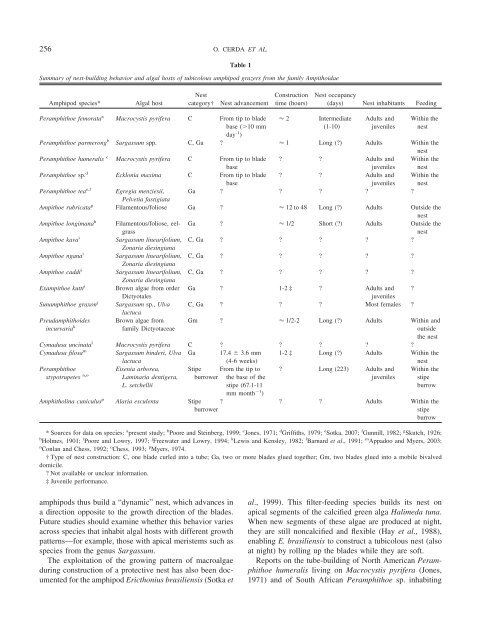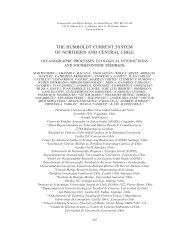Nest-Building Behavior by the Amphipod Peramphithoe ... - Bedim
Nest-Building Behavior by the Amphipod Peramphithoe ... - Bedim
Nest-Building Behavior by the Amphipod Peramphithoe ... - Bedim
Create successful ePaper yourself
Turn your PDF publications into a flip-book with our unique Google optimized e-Paper software.
256 O. CERDA ET AL.<br />
Table 1<br />
Summary of nest-building behavior and algal hosts of tubicolous amphipod grazers from <strong>the</strong> family Ampithoidae<br />
<strong>Amphipod</strong> species*<br />
Algal host<br />
<strong>Nest</strong><br />
category†<br />
<strong>Nest</strong> advancement<br />
Construction<br />
time (hours)<br />
<strong>Nest</strong> occupancy<br />
(days) <strong>Nest</strong> inhabitants Feeding<br />
<strong>Peramphithoe</strong> femorata a Macrocystis pyrifera C From tip to blade<br />
base (10 mm<br />
day -1 )<br />
2<br />
Intermediate<br />
(1-10)<br />
Adults and<br />
juveniles<br />
Within <strong>the</strong><br />
nest<br />
<strong>Peramphithoe</strong> parmerong b Sargassum spp. C, Ga 1 Long () Adults Within <strong>the</strong><br />
nest<br />
<strong>Peramphithoe</strong> humeralis c Macrocystis pyrifera C From tip to blade<br />
base<br />
Adults and<br />
juveniles<br />
Within <strong>the</strong><br />
nest<br />
<strong>Peramphithoe</strong> sp. d Ecklonia maxima C From tip to blade<br />
base<br />
Adults and<br />
juveniles<br />
Within <strong>the</strong><br />
nest<br />
<strong>Peramphithoe</strong> tea e,f Egregia menziesii, Ga <br />
Pelvetia fastigiata<br />
Ampithoe rubricata g Filamentous/foliose Ga 12 to 48 Long () Adults Outside <strong>the</strong><br />
nest<br />
Ampithoe longimana h Filamentous/foliose, eelgrass<br />
Ga 1/2 Short () Adults Outside <strong>the</strong><br />
nest<br />
Ampithoe kava i<br />
Sargassum linearifolium, C, Ga <br />
Zonaria diesingiana<br />
Ampithoe ngana i Sargassum linearifolium, C, Ga <br />
Zonaria diesingiana<br />
Ampithoe caddi i<br />
Sargassum linearifolium, C, Ga <br />
Zonaria diesingiana<br />
Exampithoe kutti i Brown algae from order Ga 1-2 ‡ Adults and <br />
Dictyotales<br />
juveniles<br />
Sunamphithoe graxon j Sargassum sp., Ulva C, Ga Most females <br />
lactuca<br />
Pseudamphithoides<br />
incurvaria k<br />
Brown algae from<br />
family Dictyotaceae<br />
Gm 1/2-2 Long () Adults Within and<br />
outside<br />
<strong>the</strong> nest<br />
Cymadusa uncinata l Macrocystis pyrifera C <br />
Cymadusa filosa m Sargassum binderi, Ulva<br />
lactuca<br />
Ga 17.4 3.6 mm<br />
(4-6 weeks)<br />
1-2 ‡ Long () Adults Within <strong>the</strong><br />
nest<br />
<strong>Peramphithoe</strong><br />
stypotrupetes n,o<br />
Eisenia arborea,<br />
Laminaria dentigera,<br />
L. setchellii<br />
Stipe<br />
burrower<br />
Amphitholina cuniculus p Alaria esculenta Stipe<br />
burrower<br />
From <strong>the</strong> tip to<br />
<strong>the</strong> base of <strong>the</strong><br />
stipe (67.1-11<br />
mm month 1 )<br />
Long (223) Adults and<br />
juveniles<br />
Within <strong>the</strong><br />
stipe<br />
burrow<br />
Adults Within <strong>the</strong><br />
stipe<br />
burrow<br />
* Sources for data on species: a present study; b Poore and Steinberg, 1999; c Jones, 1971; d Griffiths, 1979; e Sotka, 2007; f Gunnill, 1982; g Skutch, 1926;<br />
h Holmes, 1901; i Poore and Lowry, 1997; j Freewater and Lowry, 1994; k Lewis and Kensley, 1982; l Barnard et al., 1991; m Appadoo and Myers, 2003;<br />
n Conlan and Chess, 1992; o Chess, 1993; p Myers, 1974.<br />
† Type of nest construction: C, one blade curled into a tube; Ga, two or more blades glued toge<strong>the</strong>r; Gm, two blades glued into a mobile bivalved<br />
domicile.<br />
Not available or unclear information.<br />
‡ Juvenile performance.<br />
amphipods thus build a “dynamic” nest, which advances in<br />
a direction opposite to <strong>the</strong> growth direction of <strong>the</strong> blades.<br />
Future studies should examine whe<strong>the</strong>r this behavior varies<br />
across species that inhabit algal hosts with different growth<br />
patterns—for example, those with apical meristems such as<br />
species from <strong>the</strong> genus Sargassum.<br />
The exploitation of <strong>the</strong> growing pattern of macroalgae<br />
during construction of a protective nest has also been documented<br />
for <strong>the</strong> amphipod Ericthonius brasiliensis (Sotka et<br />
al., 1999). This filter-feeding species builds its nest on<br />
apical segments of <strong>the</strong> calcified green alga Halimeda tuna.<br />
When new segments of <strong>the</strong>se algae are produced at night,<br />
<strong>the</strong>y are still noncalcified and flexible (Hay et al., 1988),<br />
enabling E. brasiliensis to construct a tubicolous nest (also<br />
at night) <strong>by</strong> rolling up <strong>the</strong> blades while <strong>the</strong>y are soft.<br />
Reports on <strong>the</strong> tube-building of North American <strong>Peramphithoe</strong><br />
humeralis living on Macrocystis pyrifera (Jones,<br />
1971) and of South African <strong>Peramphithoe</strong> sp. inhabiting










